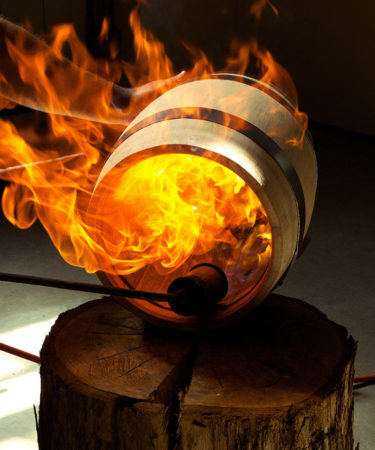Any bourbon lover, and by this point most bourbon likers, can tell you that bourbon legally has to be aged in a “charred new oak barrel.” (The same goes for “straight whiskey,” “straight Rye,” and “Tennessee whiskey.”) But not every bourbon lover will be able to tell you about char levels.
Fortunately for those of us already drowning in whiskey and spirits minutiae, “char levels” are exactly what they sound like: the degree to which a distiller chars a fresh white American oak barrel before filling it with a spirit meant for maturation. (Wine barrels and fortified wines are generally toasted, not charred.) And while the purpose of charring seems sort of intuitive—a charred surface yields a smoky flavor, right?—the effects are far more complicated. And delicious.
In fact, smoke is one of the lesser goals of charring. Unlike “peating” a Scotch whisky (or drying the malted barley over peat smoke to impart a smoky flavor, see: Laphroaig), charring the inside of a barrel won’t necessarily yield congruently smoky results. Rather, charring is done to change the nature of the oak itself, to yield the best possible reaction between wood and whiskey.
To understand “why char”—and to what extent—it’s useful to know what’s going on in the wood itself. They may stand weirdly still outside of Entwood, but trees actually have a lot going on in them. Again, fortunately, whiskey barrel science is concerned with a small group of compounds. There’s the cellulose, which creates a tight bond (but doesn’t really react with the whiskey itself), hemicellulose, lignin, tannins, and oak lactones. And the extent to which you char a barrel will have an impact on those last four.
The hemicellulose is one of the most important components of American oak. When exposed to high levels of heat (284°F and above), hemicellulose will break down into wood sugars, allowing for some caramelization on the interior surface of the barrel. If you’ve ever enjoyed a bourbon with notes of brown sugar, caramel, or toffee, you’ve got hemicellulose to thank. Just don’t do it out loud. That’d be weird. Lignin is also very important, since that’s where vanillin (aka vanilla flavor) and spice come from. The more a barrel is charred, the more the lignin yields flavors of spice and smoke.
Tannins should be a fairly familiar word to most by now (if only because we tend to blame them for our red wine headaches). Well before the oak barrel is charred, the oak itself is “seasoned,” allowed to dry out—often in the elements—to get rid of the harsher tannins. But those left over are essential for successful long-term maturation. The higher the char, the mellower the interaction between spirit and tannin.
And then there are the oak lactones. Don’t let the term scare you. They’re compounds present in many species of oak tree, but in higher volume in American oak. And they’re responsible for the woody/coconut flavors you’ll find in many bourbons. The higher the char, the less the impact of the oak lactones. (In case you doubt us, here’s a highly science-y UC Davis study, though it was done with wine.)
Which brings us to “how high can the char go???” (shouted in gameshow audience unison). If a distiller wants to, they can char (or have their barrel producer char) as long as they please; they can char until the barrel looks like the smoking remnants of a failed Wile E. Coyote caper. Most don’t wanna do that, of course, since that would basically be turning the complex mosaic of oak compounds into carbon. Levels of char can vary depending on the barrel producer or distillery, but the most commonly used levels are #1 – #4.
Most barrels aren’t charred for more than 1 minute (though Buffalo Trace, in its endless experimentations, put out a #7 level char bourbon—or 3 and a ½ minutes of straight fire—that doesn’t actually taste like liquid smoke). A No.1 Char is 15 seconds, No.2 is 30, No.3 (more common) is 35 seconds, and the classic No.4 Char is 55 seconds. The No.4 Char is also known as the “alligator char,” since after that duration of charring, the interior of the oak wood staves has the rough, shiny texture of alligator skin. Pretty bad ass nickname.
And that brings us to another wonderful byproduct of charring: filtration. Anyone who’s used a water filter and seen those little black flecks (or tasted Jack Daniel’s and enjoyed the mellowing effects of the charcoal-filtering Lincoln County Process) knows that carbon is commonly used for filtration. When your barrel is essentially lined with carbon, you’re able to filter out unwanted compounds, like sulfur compounds found in a young whiskey. The bonus of the alligator char: those deep fissures also allow the spirit to seep back and forth into the interior of the wood, creating more reaction with the uncharred oak. (Char layers tend to be between 1/8 to 1/4” thick.)
Char levels aren’t dictated for every kind of spirit, certainly not worldwide, but the amount of fire you subject your barrel to (even if it’s a simple toasting) can have a significant impact on the way the wood interacts with, well, whatever the hell you put inside it.
And now, what we all came here for. Videos of barrels being set on fire.
Jack Daniels charring its whiskey barrels.
Single barrel charring at Yoichi Distillery.
Out of focus, but still a bunch of barrels on fire. And rock music.
